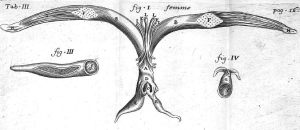
 Regnier De Graaf, Histoire anatomique des parties génitales de l'homme et de la femme ..., 1649, Bibliothèque numérique MedicaAlmost entirely overlooked throughout the 20th century, neglected by contemporary medical manuals, the clitoris has gradually returned centre stage thanks to Western feminism.
Regnier De Graaf, Histoire anatomique des parties génitales de l'homme et de la femme ..., 1649, Bibliothèque numérique MedicaAlmost entirely overlooked throughout the 20th century, neglected by contemporary medical manuals, the clitoris has gradually returned centre stage thanks to Western feminism.
Sometimes you see it, sometimes you don’t. Several studies that briefly touch on the history of the clitoris cite the work of German anatomist, Georg Ludwig Kobelt (1804 –1857), the supposed discoverer of this female organ, who bestowed on posteriority, very precise drawings. The matter is, however, vastly more complex. 19th century physicians did not discover the clitoris, they re-framed it. In fact, we are indebted to 16th and 17th century anatomical practitioners for extraordinary plates of the Clitoris.
As early as the 16th century, doctors quarrelled in all-male contests to establish who had first identified it and where the term “clitoris” originated from. It is established that at that time, and up until the mid-18th century, the clitoris was acknowledged as a scientific object, in view of its physiological role in reproduction. Indeed, it behoves to recall that as far back as the Antiquity, some physicians considered female pleasure necessary to fertilization, for it was then believed that women also possessed testicles and seed. As late as 1765, the Encyclopédie des philosophes offered under the entry “generation”: “The eager friction between the phallus and the vagina at coitus does not only induce the itchiness that arouses a man’s genitalia, it also has that effect on that of the woman … resulting in a genuine clitoridal erection, a swelling and a general tension of the full surface of spongy and nervy membranes of the vagina and matrix […] Here are the main dispositions to achieve the highest level of orgasm […] this discharge is effected like in the production of semen for men through a kind of convulsive action that makes it akin to male ejaculation and has undoubtedly played no small part in the notion that this female liquor was true semen, as prolific a liquor as the male one.”
The discoveries both of spontaneous ovulation in women (1830-1840) – ovulation disconnected from sexual arousal – and of the role of spermatozoids in fertilization (1875) – notably their mobility – turned women genitalia into passive organs. Previous representations that gave the power of fertilization to the uterus, the fallopian trumps or indeed female pleasure were henceforth overtaken by a model wherein spermatozoids pluckily broke into women’s body heading for the ovule. The clitoris accordingly lost its interest – from a scientific viewpoint, that is.
Nevertheless, the clitoris would thereafter hold the attention of doctors on the pathology aspect. Too large an organ – liable, even to bring into question its female essence against a background of hermaphroditism – was suspected to cause many sex-related disorders; nymphomania for instance. On such grounds, a surgical procedure could be carried out on the clitoris, potentially resulting in its amputation; to be known as clitorectomy. It was defined by surgeons as “a procedure consisting in the ablation of the clitoris with one stroke of scissors or scalpel, which is performed mostly on girls or women given over to masturbation”, dixit the Dictionnaire populaire de médecine usuelle d’hygiène publique et privé of 1887.
As from the end of the 19th century, it is indeed from the perspective of perils and sexual anomalies that the clitoris is perceived. Accordingly, in the 1924 issue of the Larousse médical illustré, the clitoris takes up only three lines, without illustration, but with this sparse definition: “female erectile organ, analogous to the penis glans though not traversed like it by the urethra duct. It is set upwards of the vulva”.
Not before the 60s, will new research in sexology re-discover female – clitoridean – pleasure. By the late 90s, the clitoris was reinstated as a scientific object, notably through the research of the urologist Helen O’Connel (1998). More recently, modelised in 3D, it is making its come-back complete with bulbs and legs. Has a true clitoris finally been revealed?
Continue the reading on the dictionnary : Hymen
Références :
Sylvie Chaperon, « « Le trône des plaisirs et des voluptés » : anatomie politique du clitoris, de l’Antiquité à la fin du XIXe siècle », Cahiers d’histoire. Revue d’histoire critique, 118 | 2012, p. 41-60.
Delphine Gardey, Politique du clitoris, Textuel 2019.
To quote this paper : Francesca ARENA, "Clitoris" in Hervé Guillemain (ed.), DicoPolHiS, Le Mans Université, 2021.